These new-millennia flying machines have inspired multiple names. While an eventual winner is determined, a common handle seems to be the rather awkward “eVTOL” — for electric vertical takeoff and landing. A range of abbreviations are also used: UAV, UAM, UAS, autonomous aircraft, and several others. I like multicopter — because all of them involved multiple propellers doing the lifting.
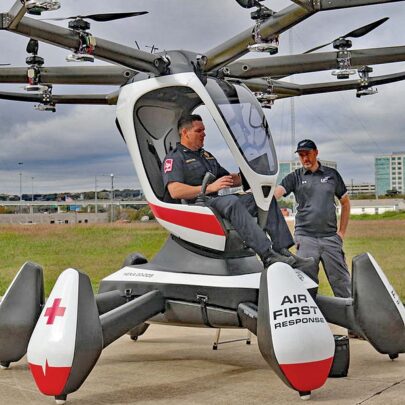 Most commonly, you hear “drone.”
Most commonly, you hear “drone.”
Yet “drone” is further confusing because we haven’t separated crewed aircraft from uncrewed aircraft and this is a major distinction. FAA has also made this separation, so for this article, I will only speak of crewed aircraft, that is, a flying machine with a pilot using controls to direct its flight. In addition, I will also stick solely to single place aircraft that can theoretically qualify as a legitimate Part 103 ultralight vehicle.
Let me first extend a quick thanks to IEEE’s Spectrum magazine for making me aware of entries I’d missed. You can read their article on Opener’s BlackFly; it’s quite interesting.
Only Part 103 Candidates
I’ve discovered five current-day entries seeking to go to market using FAR Part 103 (PDF). They aren’t alone. I’ve written about others with a similar goal: Jetson One, Kitty Hawk Flyer, and Scorpion. Except for Jetson that remains a player, the others evidently saw greener turf runways elsewhere.
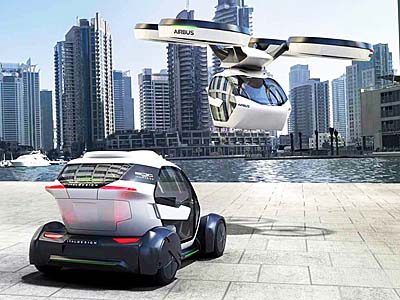
However, if asked to bet on any near-term success, I’d guess it will be a Part 103-qualifying “recreational multicopters” because anything larger remains years away, perhaps decades. Therefore, in this article, I will only touch on some genuine 103 entries. Not all will succeed but one or two might show us the way forward.
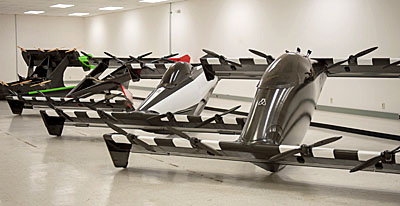
All companies are linked throughout the article. If these catch your fancy, please contact the companies directly. I will only be writing about these aircraft more extensively once they are actually for sale on the open market.
Forget Walter Mitty;
Rev Up Your George Jetson
Ryse Aero — In the words of its developer, the vehicle named Recon has a water landing system (a similar argument used by Lift’s Hexa) with “six independent outrigger floats and two fuselage floats for landing with a 250-pound occupant.” The floats are a key component as the use of multiple floats gives Recon a weight allowance it requires. Is this working around the rules? Nope, even FAA is ready to sign off on such projects.
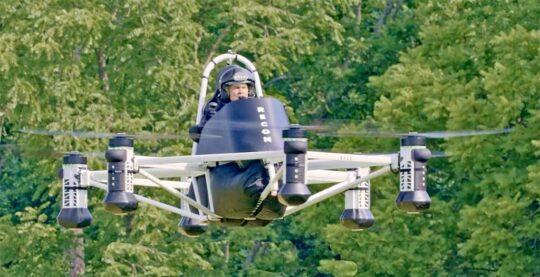
“Powered by six electric motors, the carbon-blade propellers spin at 2,000 rpm and when flying it’s not very loud,” claimed the company. Mick Kowitz, CEO and founder of Ryse Aero, is also quick to point out how easy it is to fly, noting that with as little as 45 minutes of training a user can be in the air. As with all 103 multicopter entries, redundant computer controls help a novice pilot fly without incident …or at least that’s the claim. Consider this…
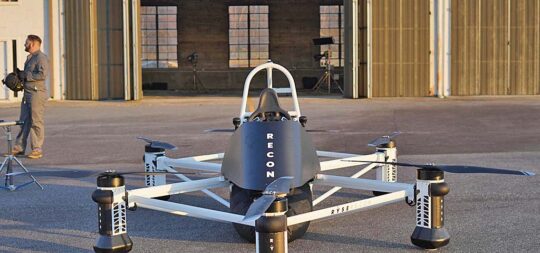
Beyond first-time pilots, Ryse Aero aims to help the agricultural community with a lot of acreage to monitor. The U.S. start-up is working on a single-seat eVTOL vehicle that could be operated by farmers, winemakers, or park rangers with minimal training under the FAA’s Part 103 rules. No pricing has been announced at this time.
More Info: Ryse Aero
Alauda Aeronautics — Ryse seems to have conventional ambitions — at least for a multicopter developer — but Alauda does not.
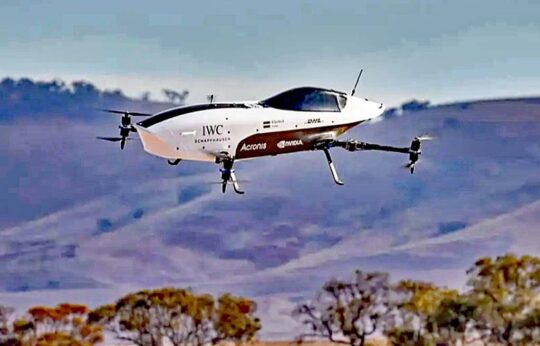
He wrote, “From the dawn of the age of the motor car, it has been racing that pushes innovation. We have Formula 1 to thank for the key performance and safety innovations we take for granted today.” He added, “Our mission is to build the ultimate performance flying car [that] will define a new mobility revolution.”
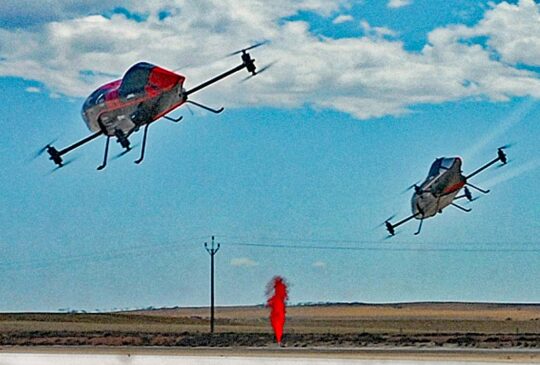
So few facts are available that it is impossible to evaluate if Alauda can meet Part 103’s Advisory Circular AC-103-7 (this is the document successfully used by Lift and Opener to obtain FAA’s blessing on their Part 103 ambitions).
More Info: Alauda Aeronautics
Jetson — Hailing from Sweden, Jetson has been generating tons of good press longer than most others and has attracted tens of millions to watch its promotional videos.
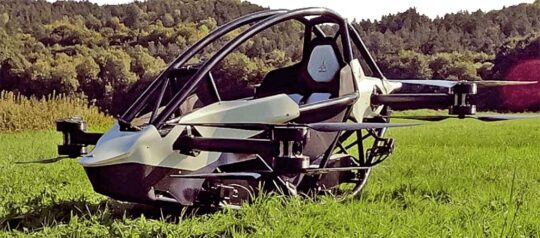
Whatever their long-term strategy, Jetson said this, “The entire 2022 and 2023 production is sold out, but we are accepting orders for 2024 delivery.” Whoa! Sold out through this year? According to their website, this translates to 226 units ordered. Not bad before the first shipment has been made.
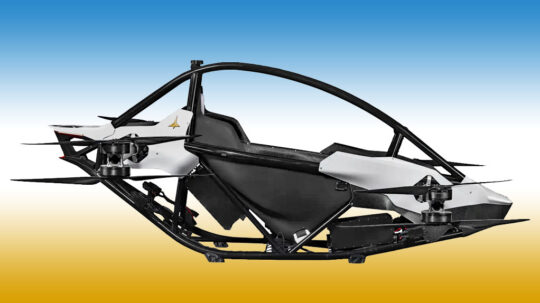
To see what I’ve had to say about Jetson before, see this article.
More Info: Jetson
Lift Aircraft Hexa — This Texas company has some of the most intriguing ideas I’ve seen in this space. I know this entry a bit more than the others as I served on the TSC that evaluated their Hexa for compliance to Part 103. Yes, thanks to — count ’em — no less than seven floats (six satellite floats on each gear pylon plus one fuselage float), Hexa gets enough extra weight allowance that even with 18 motors and 18 batteries (under each motor), it can qualify as a Part 103 ultralight vehicle. Speeds are controlled by computer.
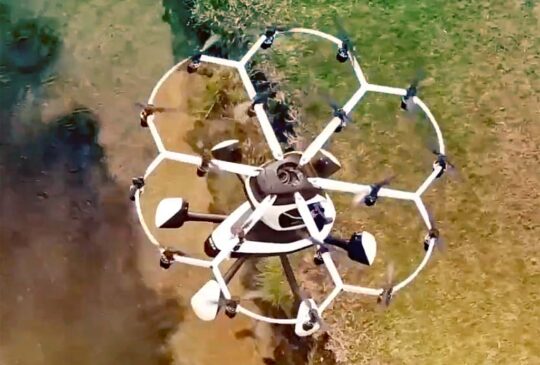
You don’t care how much this one costs (it would be over $300,000, they suggest) because Lift doesn’t plan to sell it to you. They will rent it at one of their “vertiports.” Planning several around the country, you can show up, pay the fee, sign the waiver, and take an hour’s instruction before you go fly your own Hexa solo, for your first-ever multicopter flight. The aircraft will be geo-fenced to contain its lateral movement and a safety pilot will stand by to take over if you somehow manage to overwhelm the computer controls.
I’ll tell you what… if Lift offers a flight near me, I’ll do it. Will you?
More Info: Lift Aircraft
Opener BlackFly — The one aircraft of all these that we’ve seen fly at Oshkosh (not one year but two) is BlackFly. To aviators, this is a kind of proof the others have yet to demonstrate. In the January 2023 issue of Sport Aviation, members can read a lengthy article about BlackFly and their performance at EAA’s big summer celebration of flight.
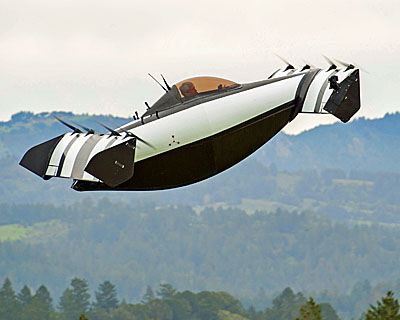
“Our vehicles are intended to liberate the public from the restrictions of two-dimensional road travel by opening up a new world of untethered three-dimensional flight,” said Opener. “Compact and simple, our vehicles are pioneering a new era of stress-free travel.”
Do you want to commute to work in your BlackFly? If it arrives on market as promised for the price of “luxury SUV,” that might mean your commuter aircraft will sell for under $100,000. If so, would you consider that affordable?
Here’s what I wrote earlier about BlackFly.
More Info: Opener
So, Should They?
…sell multicopters as “103s”?
Pilots outside the Part 103 space (which means most pilots) often raise an eyebrow at the phrase, “No pilot’s license required.” In several conversations, I’ve sensed considerable discomfort from many such aviators. Look, I get that we’re all proud of the effort we put into acquiring each certificate level of aviation knowledge and we may be disturbed by the idea of flying with others who have no formal training.
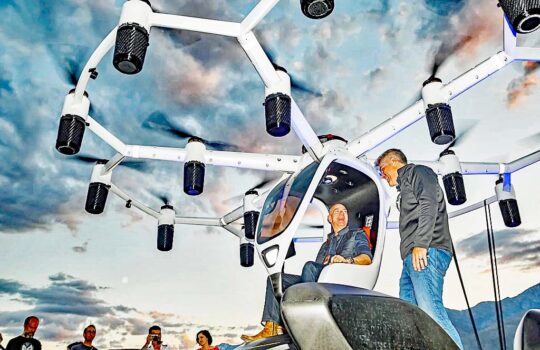
The guy who can have anything, including a flight into space on his own rocket, Jeff Bezos checks out Lift’s Hexa as Lift CEO Matt Chasen observes.
First off, nearly everyone who has already entered Part 103 has prior experience. Sure, some could use more yet is that so different from other forms of aviation? That pilot on the tarmac has all the right credentials but hasn’t flown in ten years. The individual next to him has no license but flies his Part 103 more than 100 hours per year. Who do you want in the air with you?
However, most of these multicopter developers plan to sell to the general public and train them how to fly in 45 minutes. Is that realistic? Or prudent? The pilot in you may say “No!” Yet with computer assists as we’ve seen even on household drones for years, these things may turn out to be safer than our beloved fixed or flex wings …or at least they will be when the flight control software is judged “extremely robust.”
So, do you believe it is wrong that companies offer these 103 multicopters saying, “No pilot’s license required”? Would you fly one of these (after checking everything very carefully)?
I would!
ARTICLE LINKS (Part 103 Multicopters):
- Ryse Aero Tech, factory website
- Lift Aircraft Hexa, articles on this website
- Opener BlackFly, article on this website
- Alauda Aero, factory website
- Jetson Aero, factory website
- IEEE Spectrum article on Opener BlackFly
Prior 103 Multicopter Entries:
- Kitty Hawk Flyer, articles on this website
- Hoversurf Scorpion, articles on this website
FAR Part 103 Regulation Documents:
- Part 103, the base regulation
- Advisory Circular AC-103, field guidance for FAA officials asked to evaluation an ultralight vehicle
- Airport guidance for Part 103 operations


I am a scientist, (entomologist) with a need to find a way of transporting my 210 pound self and 40 pounds minimum of equipment to the inaccessible peaks of various volcanoes in Guatemala. it would requires a mere 15 minute flight from nearby roads, to do our insect surveys. this has been a dream for many years for me and my colleagues. If these vehicles could be used for that purpose, I would be a buyer at any price under 100k. Of course I would need to hire a local, to slog to the top first and clear a landing site. By the time this becomes a reality though, I will probably be too old to manage it….Sigh.
How are any of them able to satisfy the Part 103 rule of “Has a power-off stall speed which does not exceed 24 knots calibrated airspeed”
I doubt that any have enough auto-rotation with the props. Not sure that BlackFly has enough lift in the wings. Maybe it does.
We already have a compliant Part 103 helicopter (Composite FX) that has no effective stall. A machine that can hover has nothing to prove with stall speed.
Unlike rotary-winged aircraft, auto rotation is hardly part of the language. Redundancy is.
But a helicopter has a big rotor with inertia and autorotation. Something like the Blackfly props have negligible inertial and cannot autorotate. IF the regulations permitted reliance on redundant power systems, okay. But my (admittedly hurried and inexpert) internet searching hasn’t found an amendment to the regulations to say something like a powered Part 103 ultralight should have.
“…a power-off stall speed which does not exceed 24 knots calibrated airspeed or an independent redundant alternate power source capable of returning the aircraft safely to the surface below.”
Is there such an amendment? …special exception for eVTOLs?
Most Part 103 experts are pleased FAA has left this 1982 regulation virtually unchanged. Despite numerous technology improvements over the years, this simplest-of-all rules has continued to function. FAA did not envision something like multicopters when this rule was written.
All that said, the entire point of multicopters with multiple batteries powering multiple motors controlled by computers is that redundancy supplants the need for the flywheel effect of a large rotor. Only the future will prove if that theory is correct in emergency situations. Some of these, like Lift Aircraft’s Hexa also offers a low-altitude emergency parachute system.
There’s a market niche here. It is the same niche occupied by jetskis on the water and ATVs on land. Fun is zooming around, sometimes solo but often in groups, as existing ultralights often do. They need to be trailerable. Batteries need to be swappable, fly for 20 minutes and wait a day to fly again isn’t going to work. The racing idea might work, but not the commuting. Farmers I know would want to see the business case, they’d be competing with drones equipped with ag-specific sensors for data-driven agriculture.
I do worry about separation. I’ve encountered groups of 3 or 4 trikes over 4000′, they might as well be stopped relative to a 150kt aircraft and they’re not talking or squawking. And a group of five strung out in trail over several miles claiming to be a formation and doing a straight-in approach to a local airport. At least one of them was talking but they effectively shut down the busy airport.
Then of course there’s the “hold my beer” crowd.
You make some valid points but it is already possible to keep even swarms of uncrewed drones from bumping into one another. Modern airshows incorporate hundreds of drones flying elaborate formations… and that’s today, with much more software development to follow.
However, I think you struck a good chord with your “flying for fun” comment. That’s primarily what Part 103 vehicles achieve today and I see nothing wrong with that.
I don’t see any problem with fun either. These companies need paying customers and people will pay to have fun But it needs to be user-friendly and safe. These are crewed aircraft, not drones, sharing airspace with much faster aircraft while not participating in radar or ADS-B. Right now they are a minor nuisance. What if there are thousands of them? How is that going to work?
Computer-controlled drones at airshows in waivered airspace are an entirely different matter. That’s analogous to an amusement park ride.
“Modern airshows incorporate hundreds of drones flying elaborate formations” is true. Will all the “manned drones” be controlled by a single totalitarian computermeister? Will there be no Pilot in Command aboard? Time will tell.
Re: Mike Taylor’s comment on trikes (vs my Varieze):
Hopefully the Technical Standards Committee that Lift and Opener are creating with LAMA gains more support from the industry. Perhaps they can enforce some sort of industry standard minimal training that comes with the purchase of these machines. Not just on how to operate them, but some ground schooling on things like airspace, right-of-way rules, etc. No need to get the FAA involved, just something that the industry self enforces.
Without the industry enforcing some sort of training for their products, I can easily see these things doing to the Part 103 world what ready-to-fly drones have done to the RC model aircraft community. If these things get in the hands of yahoos with no awareness or concern for airspace or right-of-way, then the DEA, CBP, DHS, and DOD will be busting down the FAA’s door demanding that everyone down to the guy in a foot-launched PPG have some sort of operating ADS-B out device in order to fly. This is something happening right now with RC model aircraft.
BlackFly has no competition. Super easy to fly; if you can fly a drone you can fly this in half hour training.
Too bad it’s limited to about 20 minutes flying. If they could make a 2-seat version that would fly 1 hour for under $100K, I would sell my plane and buy one.
Of course, a two-seater cannot be Part 103 and any other level of FAA approval will increase the price substantially. It will also delay its arrival on the market.
Quoting Princess Bride: “Flying. You keep using this word. I do not think it means what you think it means.”
🙂
It will be interesting to understand how the FAA will treat the non-licensed operator in the cities surrounded by controlled airspace. That is not a 45 minute understanding. Current 103 operations aren’t focused in Class B,C,D airspace. Ryse and others talking about farmers outside of controlled airspace is conceptually different than the rich person in a city thinking it is a cool traffic alternative. I’m certainly ready to try one….but not ready to bump into one in the sky over my house :-). Today’s 25 mile range is tomorrows 50 miles then et.al. $100-300K will certainly be a traffic deterrent, but the price of ground vehicles keeps encroaching toward the lower end.
You make valid comments, but Part 103 aircraft are not permitted over populated areas, therefore, these entries will not be air taxis. In addition, they can easily be geo-fenced, meaning they simply cannot go places where they are not permitted or welcome, assuming the software writers are knowledgeable about such things.
These are all complete deathtraps. Just wait until ‘everyone is shocked’ when one plummets with no Emergency Reserve System.
Lift Aircraft’s Hexa does have such a rescue system. It’s overly elaborate, I believe, but it has the potential to work at extremely low altitudes.